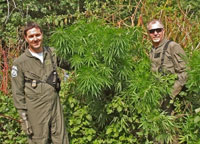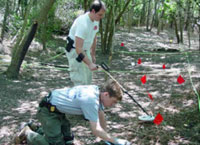Drug Control Program
 The basic mission of Law Enforcement and Investigations (LEandI) is public and employee safety, resource protection, enforcement of U.S. Criminal Law, and to provide enforcement expertise to other agency managers. The National Forest System Drug Control Act of 1986, as amended in 1988, and Title 16 of the United States Code (U.S.C.), provides authorization to the Forest Service (FS) for law enforcement activities relating to the Controlled Substance Act and Title 21 U.S.C. Subsequently, officers of the FS are charged with performing drug enforcement duties on National Forest System (NFS) lands or in areas with a nexus to NFS lands.
The basic mission of Law Enforcement and Investigations (LEandI) is public and employee safety, resource protection, enforcement of U.S. Criminal Law, and to provide enforcement expertise to other agency managers. The National Forest System Drug Control Act of 1986, as amended in 1988, and Title 16 of the United States Code (U.S.C.), provides authorization to the Forest Service (FS) for law enforcement activities relating to the Controlled Substance Act and Title 21 U.S.C. Subsequently, officers of the FS are charged with performing drug enforcement duties on National Forest System (NFS) lands or in areas with a nexus to NFS lands.
The production of marijuana and other illegal drugs on NFS lands creates photo of booby traps problems for all land management programs. Marijuana cultivation occurs in many areas that employees and visitors utilize for a myriad of legitimate purposes. Growers are known to "booby trap" or protect their sites which creates a genuine threat to the public, forest employees, and law enforcement. These illegal activities can also damage sensitive riparian areas, are often harmful or fatal to wildlife, and lead to other environmental problems.
 NFS lands will continue to be vulnerable to these illegal activities. Between 1996 and 1999 (4 years), the FS eradicated over 1,462,300 marijuana plants from 19,380 sites. This equates to just over 3,226,000 pounds of illegally produced marijuana. Estimates of the actual plants being grown is yet to be determined.
NFS lands will continue to be vulnerable to these illegal activities. Between 1996 and 1999 (4 years), the FS eradicated over 1,462,300 marijuana plants from 19,380 sites. This equates to just over 3,226,000 pounds of illegally produced marijuana. Estimates of the actual plants being grown is yet to be determined.
The Daniel Boone National Forest in Kentucky eradicates almost half of the total plants seized by the FS, however, forests in California are seeing a significant rise in the amounts of marijuana being grown and in the size of the gardens found. International Drug Trafficking Organizations are being linked to NFS lands. These organizations are spreading from the west coast forests to the east and north.
Clandestine methamphetamine laboratories are also on the increase on NFS lands. In 1999, 107 lab or dump sites were found compared to 41 sites found in 1996. In 2000, that number is expected to be substantially higher.
 In addition to the actual production of illicit drugs on NFS lands, the FS is also faced with the increased smuggling of drugs across forests that share a common boundary with two international borders. The traditional southwest border is still very active with undocumented aliens and drugs crossing NFS lands, but the border with Canada and its hundreds of remote adjacent NFS lands is experiencing a tremendous rise in smuggling activity.
In addition to the actual production of illicit drugs on NFS lands, the FS is also faced with the increased smuggling of drugs across forests that share a common boundary with two international borders. The traditional southwest border is still very active with undocumented aliens and drugs crossing NFS lands, but the border with Canada and its hundreds of remote adjacent NFS lands is experiencing a tremendous rise in smuggling activity.
Addressing these public safety and resource protection issues, and reducing the domestic supply of illegal controlled substances is essential. The FS is working in conjunction with the Office of National Drug Control Policy (ONDCP) in meeting the goals as outlined in the National Drug Control Strategy. The FS uses multiple resources from both the regular military and from National Guard units around the country. This support is critical to its overall mission in drug enforcement.
 LEandI is involved with ONDCP's domestic program of High Intensity Drug Trafficking Areas (HIDTA). Its involvement with this effective program of multi-agency task forces from Federal, State, and local agencies will increase to meet the demands of the ever widening drug problem on NFS lands.
LEandI is involved with ONDCP's domestic program of High Intensity Drug Trafficking Areas (HIDTA). Its involvement with this effective program of multi-agency task forces from Federal, State, and local agencies will increase to meet the demands of the ever widening drug problem on NFS lands.
Drug enforcement efforts by personnel of the U.S. Forest Service, Law Enforcement and Investigations, will continue to be aimed at stopping the illegal cultivation of marijuana, preventing the establishment of clandestine laboratories, and curtailing the smuggling of controlled substances across all NFS lands.


